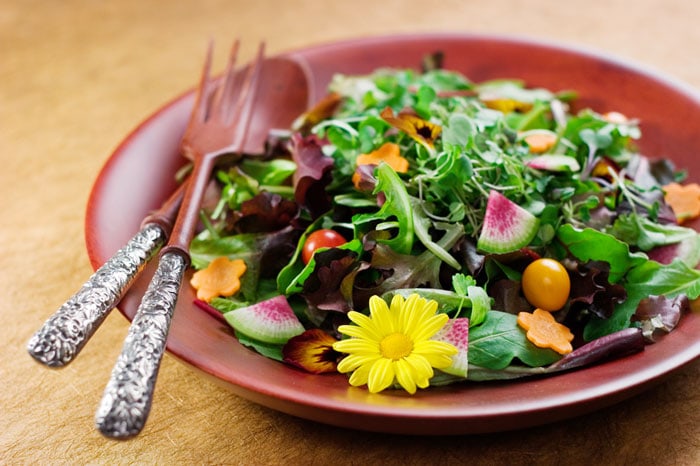
Written By: Beth Ehrensberger, RD
Title: Registered Dietitian
Alumni: University of Tennessee, Knoxville
Last Updated on:

It used to be that “salad” was synonymous with “healthy.” But over the years, the standard restaurant plate of healthy salad veggies has morphed into a platter of greens piled high with things like fried chicken and heaps of cheese, all hiding under a thick blanket of dressing. Just about every chain restaurant has decadent salads on the menu, like the Honey Crisp Chicken Salad at Uno Chicago Grill. With a big bowl of greens weighing in at 820 calories and 52 grams of fat (10 of them saturated!) it’s a salad that’s anything but healthy.
Our advice? Sometimes it’s best to skip the restaurant-crafted salads and head over to the salad bar instead – you’ll have more control over what goes into your mix. If you don’t have a build-your-own option, just make sure you carefully scrutinize your entrée salad’s ingredients, since many can be diet traps. Whether building your own at the salad bar, or ordering off the menu, use our tips to help choose a better healthy salad.

Table of Contents
When it comes to veggies, don’t hold back: load your plate with a colorful variety of nature’s bounty. To maximize the nutrition impact, aim for at least one vegetable selection from each color group (for example, greens= spinach, whites=cauliflower).
Cheese: Cheese can be a great addition to your healthy salad, since it adds around 4-7 grams of protein per ounce, but it also comes with a weighty price. Generally speaking, most whole milk cheeses have around 4-6 grams (about a quarter of a day’s worth) of saturated fat and 100 calories per 1 oz. To salvage your salad, try a sprinkling of strong-flavored cheese, like blue or feta. Just a tablespoon or two adds big flavor to your salad without a calorie or fat splurge – and you’ll get 3-5 grams of protein, too.
Protein: Bring on the beans! For less than 150 calories per half cup, you can add around 7 grams of both protein and fiber to your healthy salad with beans like garbanzo or kidney. If you’re lucky enough to find edamame on the bar, scoop them up, since a half-cup serving adds just 150 calories and a whopping 14 grams of hunger-curbing protein. If you want to add more fill-appeal, add a lean choice like one 3 oz serving of grilled chicken or a boiled egg – both excellent choices for 100 calories or less. Stick to these guidelines and you can add healthy protein to your salad without too many extra calories or too much extra fat. But be careful not to go overboard!
Dressing: Surprise! Fat-free dressing isn’t your healthiest choice. Research shows that beneficial phytonutrients, like carotenoids (think orange veggies) are nearly unabsorbed when dressed with a fat-free dressing, as opposed to a full-fat version. But that’s not your cue to pour on the dressing freely. Opt for one small ladle (about 2 tablespoons and 100 calories) of a vinaigrette instead of a creamy dressing, which can tack on about 40 more calories per tablespoon.
Extras: Pass on the calorie-busting bacon bits, croutons, tortilla strips, and buttery pita wedges in favor of one or two choices like these nutrient-dense toppers: a tablespoon of nuts, seeds, dried fruit, olives, or a couple slices of avocado. If you’re craving carbs, pick up a few saltines. At only 25 calories per two-cracker pack, they’re great on the side or crumbled on top for a satisfying crunch.
Skip any pre-made pasta, chicken, or creamy fruit salads – they’re prime ways to ratchet up calories and fat. Besides, with all of the healthy salad components already filling your plate, there’s no room for these diet bombs!
Make a filling and healthy salad by mixing a wide variety of veggies with lean proteins and tasty toppings that add nutritious punch as well as crunch.
Alumni: University of Tennessee, Knoxville – Beth Sumrell Ehrensberger is a Registered Dietitian and holds a Master Degree in Public Health. An experienced nutrition counselor, writer and public speaker, Beth specializes in translating complex nutrition information into practical concepts. Beth was awarded a Nutrition Communications Fellowship to the National Cancer Institute, and has worked on the internationally recognized Nutrition Action Healthletter of the Center for Science in the Public Interest.
cheese, protein, salad, salad dressing